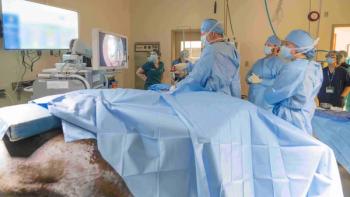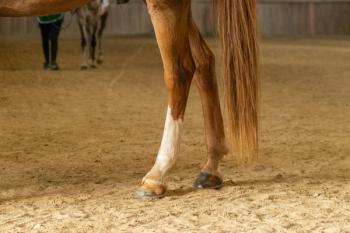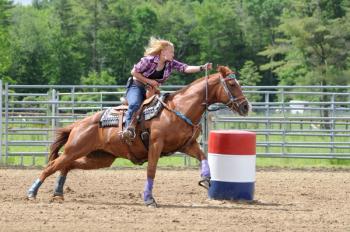
Reproductive emergencies in the mare (Proceedings)
Assement of reproductive emergencies in the mare
Occurrence
• Breeding
o Rectal tears
• Palpation
• Penetration by stallion
o Vaginal Tears
• Penetration by stallion
• Peri-parturient
o Dystocia
o Hemorrhage
o Uterine
• Torsion
• Prolapse
• Rupture / tear
• Retained fetal membranes
• Metritis
o Vagina
• Rectovaginal Tears
o Gastro-intestinal
• Damage to viscera
• Rectal prolapse
Breeding associated emergencies
• Rectal Tears
o Associated with:
• Palpation
• Penile penetration of rectum by stallion
o Signs
• "Feeling" of release of rectal tissue around arm
• Blood on sleeve or penis
• Onset of shock
• Signs of peritonitis
• Usually colic
• Straining to defecate
o Types
• Grade 1
- Involves only rectal mucosa and submucosa
• Grade 2
- Through muscular layer
• Mucosa and submucosa intact
- No bleeding
- Forms diverticulum
• Grade 3a
- Only serosal layer is intact
• Grade 3b
- Occurs dorsally
- Mesorectum and retroperitoneal tissues are intact
• Grade 4
- All layers disrupted
- Fecal contamination of peritoneum
o Incidence
• Most occur dorsally
• 15 – 55 cm from the anus
• In one retrospective study of 85 horses with rectal tears (Eastman TG et al Equine Vet Edu 2000 12(5):263-266.)
- 47/85 associated with routine pregnancy exams
- Grade 1 - 93% survived to discharge
- Grade 2 – 66% (2/3) survived to discharge
- Grade 3a – 70%
- Grade 3b – 69%
- Grade 4 – 6%
• Few cases of penile penetration in literature
- 2 at MDS-EMC in last 5 years
- Both lateral wall
- Grade 3b
- Both survived
o First-Aid for Rectal Tears
• Exam of tear
• Sedation
• Buscopan
• Careful palpation
• Remove feces
• Pack rectum
- 20 cm cranial to tear
• Close anus
• Epidural
- Transportation concerns
• Antibiotics
- Broad spectrum
- Penicillin (potassium or sodium penicillin 22,000 IU; IV)
- Gentamicin – 6.6 mg/kg IV
- Metronidazole – 15 mg/kg PO
• Flunixin meglumine – 1.1 mg/kg IV
• Tube with oil
• IV fluids
- If in shock
• Withhold food
• Refer for evaluation
• Vaginal Tears
o Occur during intromission
o Uncommon
o Mild to severe trauma to vagina
o Vaginal rupture
• Usually adjacent to cervix
• Dorsolateral
• Can also affect lateral wall of vestibule
• Semen is not sterile
• Results in peritonitis
• Evisceration (Tulleners EP et al JAVMA 1985 186(4): 385-7)
o Partial thickness
• Peri-vaginal abscessation if not identified acutely
o Signs
• Vaginal bleeding
• Colic
- Minutes to hours post-breeding
• Straining
• Peritonitis (signs)
• Fever
• Depression
• Lethargy
o First Aid for Vaginal Rupture
• Broad spectrum antibiotics
• Peritonitis
• Flunixin meglumine
• If evisceration:
- Reduce and pack with sterile soaked towels
- Large enough so they won't pass into the abdomen through the tear
- Close vulva
- Clamps or suture closed
• Treat shock
• Refer for medical and surgical treatment
Peri-parturient emergencies
• Dystocia
o Epidemiology
• 4% Thoroughbreds (McKinnon and Voss Equine Reproduction 1993 pp 578)
• 10% Draft breeds (McKinnon and Voss Equine Reproduction 1993 pp 578)
• 10% Miniature Horses
o Signs
• Colic in term mare with other signs of imminent parturition
• No amnion visualized after 5 minutes in Stage 2 labor
• No foal after rupture of chorioallantois
• One hoof but no further progress despite abdominal contractions of mare
• Nose is presented first
• See the ventral portion of the foot
• Nothing palpable in vagina despite signs of active labor
o Types of Malposition
• Anterior presentation
- Head and neck reflection
- Limb malposture
- Foot-nape posture
- Rotated
- Dorsal, lateral, ventral
• Posterior presentation
• Transverse presentation
o Treatment
• Assisted vaginal delivery
- Sedation
- Epidural
- Lubrication
• Controlled vaginal delivery
- Anesthesia
- Hindquarters elevated
- Lubrication
• Fetotomy
• Cesarean section
- Referred for surgery
• Time is of the essence for foal survival!
- In a large retrospective study of 247 horses (Byron et al EVJ 2002 35(1):82-85)
- Time from chorioallantoic rupture to delivery
• Foals survived to discharge = 71.7 min ± 34.3 min
• Non-survivors = 85.3 ± 37.4 min
• 42% of foals delivered alive
• 29% survived to discharge
• 91% of mares discharged
• Treatment
- Except for fetotomy there is no effect of method of delivery on** +
• Mare survival
• Mare fertility
• Peri-parturient Hemorrhage
o Older, multiparous mares
o Most common cause of death in older foaling mares
o When?
• At parturition
• Post-partum (24-48 hours)
• Pre-partum
o Where?
• Middle uterine artery
• Utero-ovarian artery
• External iliac artery
o Why?
• Degenerate process in arterial wall (Rooney JR. Cornell Vet 1964)
• Low serum copper levels (Stowe HD J Nutr 1968)
• Predisposing factors (McCarthy PF Equine Pract 1994)
- Large foal
- Assisted delivery
o Retrospective studies (Rooney. Cornell Vet 1964)
• 10 mares
- 2/10 died at 7 months of gestation
- 8/10 died at foaling
- 3/10 ruptured left utero-ovarian artery
- 7/10 ruptured right utero-ovarian/middle uterine/ external iliac artery
- Histology
• Degeneration of the internal elastic lamina
• Intimal fibrosis
• Thickening and accumulation of metachromatic, mucoid material in the intima and media at aneurysm site
• → Lesions are related to the aging process!
• 13 mares (Pascoe RR. Vet Rec 1979)
- Group 1 - 8 mares
• 6/8 mares - death within 30 min to 20 hours postpartum
• 2/8 mares - death 3 days/25 days postpartum (ruptured the hematoma)
• 7/8 rupture of right ovarian or utero-ovarian artery
- Group 2 – 5 mares
• No clinical signs
• 5/5 hematoma in right broad ligament
• 1 died at parturition due to acute hemorrhage
• 1/4 re-bred after hematoma resolved (died postpartum)
• 3/4 palpable masses in broad ligament- not re-bred
o Signs
• Colic
• Sweating
• Pale mucous membranes
• Rapid pulse
• Anemia
• Intra-peritoneal
- Rapid deterioration
- Acute shock signs
• More subtle signs if hemorrhage is contained in broad ligament
o Diagnosis
• History
• Clinical signs
• Physical examination
• Hematology
• Transabdominal ultrasound
• Abdominocentesis
• Transrectal palpation/ultrasound
o Treatment
• Prevent activity/excitement
• Quiet, dark environment
• Warmth
• Sedation (acepromazine)
• Keep foal close by-if possible/safe
- If not-foal requires support
• Plasma expansion therapy
- Crystalloids (hypertonic saline, LRS)
- Colloids (Hetastarch, plasma)
- Whole blood transfusion
- Blood substitutes (Oxyglobin)
• Oxygen supplementation via nasal insufflation
• Antifibrinolytic drugs (aminocaproic acid, tranexamic acid)
• Anti-inflammatory drugs
• Glucocorticoids (prednisolone sodium succinate)
• Analgesic drugs
- Opioids (butorphanol)
- Anesthetics (lidocaine)
• Broad-spectrum antibiotics
• Anti-oxidant drugs (DMSO, Vitamin E/selenium)
• Oxytocin – low dose therapy for uterine involution
o Prognosis for survival
• Depends on severity and location of hemorrhage
• Worse if intra-abdominal hemorrhage present
o Prognosis for future fertility
• Rebreeding unsuccessful unless hematoma in broad ligament resolves
o Recurrence
• High risk with future breeding/foaling
• Uterine Torsion
o Incidence 5-10% of all serious equine obstetric problems
• Less frequent than in cows but greater difficulty in resolving the torsion and lower survival rate in horses
o Underlying cause unknown
o Contributing factors:
• Vigorous fetal movement
• Sudden falls
• Large fetus in small fluid volume
• Lack of tone in the pregnant uterus
o Signs
• Colic
• Restlessness
• Sweating
• Anorexia
• Frequent urination, sawhorse stance
• Looking at flank, kicking at abdomen
• TPR – normal to slightly elevated
o Complications
• Restriction of blood flow through uterine and utero-ovarian arteries
• Arterial rupture and fatal hemorrhage
• Thrombosis of large uterine arteries and veins (common)
• Rupture of the vessel
o Diagnosis:
• Physical examination
• Transrectal palpation
- Broad ligaments are tense and spiraling in the direction of the torsion
- Clockwise vs. counterclockwise
- Small colon might be constricted by torsion and impede ability to perform complete rectal palpation
- Determine viability of fetus, integrity of uterus and direction of torsion
• Vaginal examination – often not helpful
o Treatment
• Nonsurgical
- Mare is term and cervix is dilated → manual detorsion and assisted delivery
- Mare is preterm and cervix is closed/vagina or cervix are involved → Rolling of anesthetized mare
- Risks:
• Uterine rupture
• Risk of placental detachment
• Abortion
• Fetal/maternal death
• Recurrence of uterine torsion during same pregnancy
• Surgical
- Flank laparotomy
- Ventral midline approach (at term gestation)
- Risks:
• Premature placental separation
• Uterine wall necrosis, uterine tearing
• Peritonitis
• Partial or complete dehiscence of incision
• Recurrence of torsion during same pregnancy
o Prognosis
• Mare survival rate 84% (Chaney KP et al. AAEP proceedings 2006)
- 97% <10 mo gestation
- 65% >10 mo gestation
- 67% successfully rebred
- Foal survival rate 54%
- 72% <10 mo gestation
- 32% >10mo gestation
• Surgical management 73% survival rate (Pascoe RR et al. JAVMA 1981)
• Nonsurgical management 85% survival rate (Wichtel JJ et al. JAVMA 1988)
• Uterine rupture
o Associated with:
• Fetotomy
• Excessive manipulation during dystocia
• Fetal malposition
• Uterine torsion
• Uterine lavage
• Normal delivery
o Complications:
• Visceral herniation
• Peritonitis
• Hemorrhage
• Shock
• Death
o Most common site:
• Dorsal aspect of uterus
o Clinical signs (Dolente BA. Critical peripartum disease in the mare. Vet Clin Equine 2004)
• Anorexia
• Fever, malaise
• Tachycardia, tachypnea
• Ileus, colic
• Dehydration
• Signs of diffuse, severe, septic peritonitis
• Hypovolemic shock
• Signs may not be evident until 24-48 hours after parturition
o Diagnosis
• Can be challenging
• Abdominocentesis
• Transrectal palpation
• Palpation of the uterine lumen
• Laparoscopy
• Exploratory celiotomy
o Treatment
• Conservative management
- Successful if tear is small, on dorsal aspect of uterus, minimal hemorrhage, no uterine therapy required
- Supportive therapy
- Treat shock and peritonitis
- Cross-tying to prevent abdominal herniation through tear
• Surgical management
- Ventral midline celiotomy
- Flank approach
• Supportive therapy
- Antibiotics
- NSAIDs
- IV fluids
- Abdominal lavage
- Adhesion prevention (heparin, etc)
- Oxytocin
- Laxatives
o Prognosis
• Variable
• Uterine prolapse
o Less likely than in cows due to cranial attachments of uterus
o Associated with:
• Normal delivery – uncommon
• Abortion (8-10 months gestation)
• Prolonged parturition/dystocia
• Retained placenta
• Old age
• May occur several hours after fetal delivery
o Complications:
• Retained fetal membranes
• Uterine rupture
• Bladder eversion/prolapse
• Intestinal herniation/rectal prolapse
o Clinical signs (Perkins NR, Frazer GS. Vet Clin North Am Equine Pract 1994)
• Mild to moderate tenesmus
• Restlessness, pain
• Anxiety, anorexia
• Tachycardia, tachypnea
• Hypovolemic/endotoxic shock esp. if excessive bleeding or incarceration of intestines present
• Rapid weak pulse, rapid shallow respiration
• Pale mucous membranes
• Depression, prostration, rapid death
o Diagnosis
• Presence of prolapsed organ hanging from vagina
o Treatment:
• Sedation and analgesia
• Lavage and examination of the uterus
• Gentle replacement of the uterus
• If uterus is edematous:
- Compression of the uterus with bandage before replacement
• Complete reduction must be performed!
• Placement of vulvar retention sutures/Caslick's
• Supportive therapy (incl. intrauterine therapy, laxatives)
o Prognosis
• Good
• Future fertility
- Depends on degree of endometrial damage during the prolapse
• Recurrence rate
- Unknown
- Considered to be low
• Retained fetal membranes
o Failure of passage of part, or all, of the chorioallantoic membrane within a specific time period of fetal delivery (3 hours)
o Most common post partum complication
o Incidence of RFM 2-10%
o Most common site - tip of the non-gravid horn
• Microcotyledons more deeply interdigitated
• Edematous tip of gravid horn more squashed and stunted
o Predisposing factors
• Mechanical interference with normal expulsion
• Hormonal imbalances
o Complications
• Severe metritis
• Septicemia/Endotoxemia
• Laminitis
o Clinical signs
• Portion of fetal membranes protruding through vulvar lips
• Retention may occur without any membrane appearance
• Vaginal discharge
• Fever
• Anorexia
• Depression
• Laminitis
o Treatment
• Tetanus prophylaxis
• Oxytocin (10-40 IU)
- Stimulate separation of microcotyledons from endometrium
• Distention of chorioallantoic sac with 5-15L saline and ligation to contain fluid in it
• Tying of protruding placental remnants in knot above the mare's hocks
• Tying a weight to protruding fetal membranes
• Manual removal of RFM
• Correct calcium imbalance
• Controlled exercise
• Systemic treatment
- Antibiotics
- NSAIDs
• Uterine lavage
- Uterine infusion with antibiotics (oxytetracycline)
• Septic Metritis
o Sequelae of retained fetal membranes
o Following dystocia:
• Greater risk of toxic metritis and laminitis
o Delayed uterine involution
o Increased autolysis of the placenta
o Severe bacterial infection
o Diagnosis
• Rectal examination
- Large, thin walled uterus
- Flaccid tone
- Moderate to large amount of intraluminal fluid
• Transrectal ultrasound
o Complications (Blanchard T et al. Comp Cont Educ Pract Vet 1990
• Septicemia
• Endotoxemia
• Laminitis
o Treatment
• Antibiotics
• NSAIDs
• IV fluid therapy
• Large volume uterine lavage
• Uterine infusion with antibiotics
• Oxytocin
• Controlled exercise
• Laminitis prevention
• Recto-vaginal Tears
o Three grades
o Although they can look severe acutely immediate surgery is rarely necessary
o Treat symptomatically
• NSAIDS
• Antibiotics
o Metritis
• Chronic
o Incontinence
• Occasionally
• Gastro-intestinal Related Emergencies
o Bowel rupture
• Cecal/colonic rupture
• Most common gastrointestinal catastrophe associated with parturition (Rossdale 1994)
o After normal parturition or dystocia
o Occasionally before parturition
o Why?
• Trauma during delivery
• Focal necrosis of intestinal wall
• Thromboembolism
• Tapeworms
• NSAID administration
o Clinical Signs
• Acute abdominal pain
• Septic shock
o Results in
• Peritoneal contamination
• Severe peritonitis
• Profound endotoxemia
• Death within 24 hours
o Diagnosis
• Physical examination
• Abdominocentesis
• Transrectal palpation
- Roughened peritoneal surface
- Pneumoperitoneum
o Treatment
• Euthanasia
o Trauma to small colon/small intestine
• Injury to
- Bowel wall
- Mesocolon/mesojejunum
- Ischemic necrosis of colon/jejunum
• Associated with
- Normal parturition
- Dystocia
- ± type III or IV rectal prolapse
• Clinical signs
- Depression
- Moderate to severe colic
- Absence of fecal passage
- Febrile
- Decreased gastrointestinal motility, gastric reflux
• Diagnosis
- Physical examination
- Rectal examination
• May be non-specific
- Abdominocentesis
• Septic/non-septic peritonitis
- Laparoscopy
- Exploratory celiotomy
• Treatment
- Resection and anastomosis
- Colostomy
• Prognosis
- Variable (36% small colon)
• Rectal prolapse
o Due to prolonged or forceful tenesmus
o Parturition/dystocia
o Rectal mucosa is apparent
o Variable degree of inflammation, cyanosis, trauma, necrosis
o 4 types
• Type I – only rectal mucosa involved
• Type II – complete prolapse of rectal ampulla
• Type I and II – usually no signs of colic
• Type III – prolapse of rectum with evagination of descending colon
• Type IV – prolapse of descending colon or rectal intussusception (associated with dystocia in mares)
• Type III and IV may be associated with tearing of the mesocolon, avascular necrosis of descending colon – may result in abdominal pain
o Diagnosis
• Examination and palpation of prolapsed tissue
• Abdominocentesis
o Treatment
• Epidural anesthesia
• Manual reduction
- Reduce edema
- Application of glycerin, dextrose
• Placement of purse string suture
• Administration of laxatives
• Laparoscopy
• Ventral midline celiotomy
o Prognosis
• Depends on viability of small colon and rectum
Newsletter
From exam room tips to practice management insights, get trusted veterinary news delivered straight to your inbox—subscribe to dvm360.




